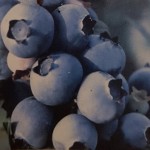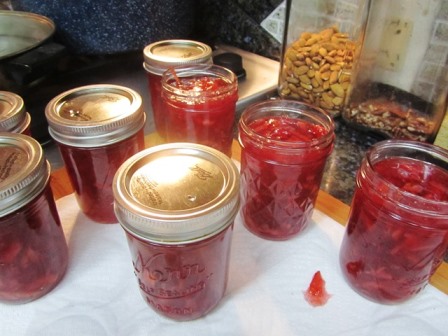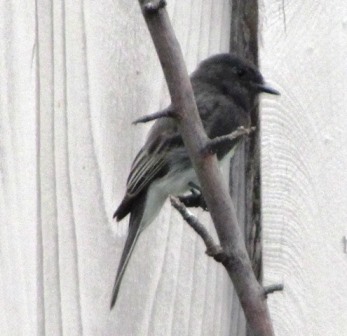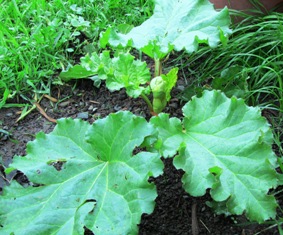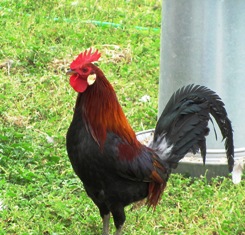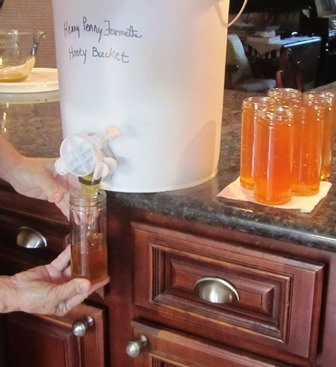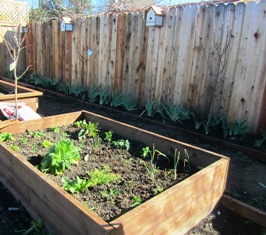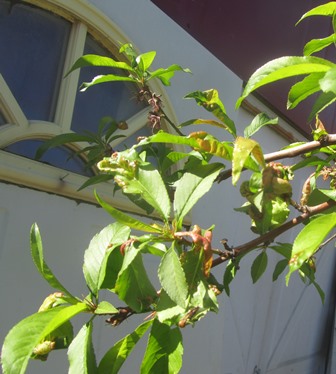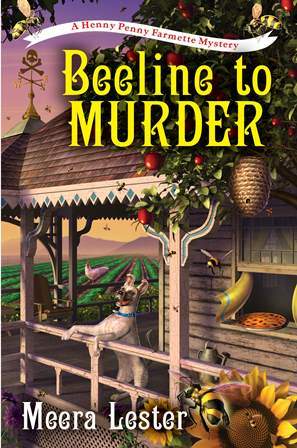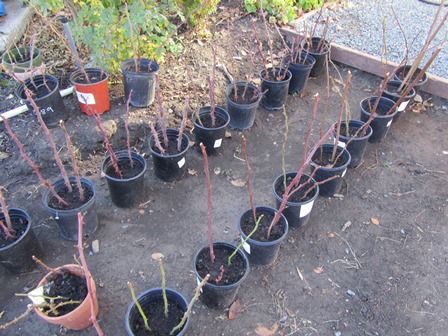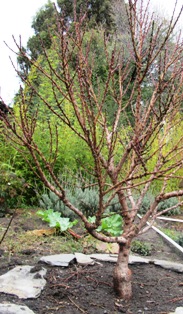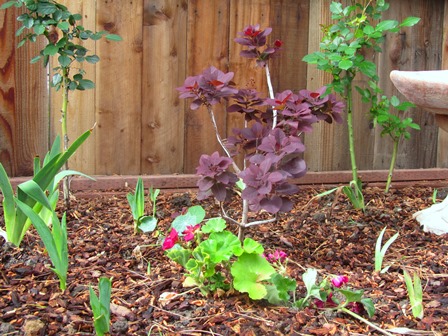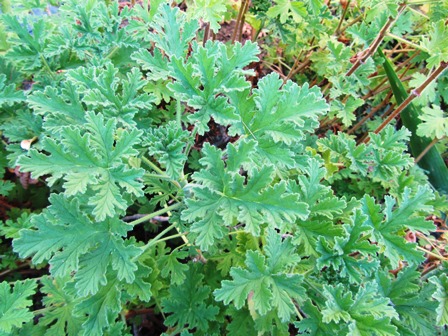Backyard Blueberries Taste Delicious and Are Easy to Grow
What’s not to love about blueberries. They’re almost a a perfect fruit. They are delicious, packed full of antioxidants, easy to grow, and add lovely landscape interest to any garden.
Grow blueberries in containers or in the ground but keep in mind that these plants like well-drained acidic soil. The pH should be on the low side, ranging from 4.5 to 5.5.
In the hottest inland valleys of the Bay Area, blueberries do best with morning sun and shade for hot afternoons. Northern Highbush varieties require winter chilling (800 to 1000 chill hours) to get the plants to produce fruit. Southern Highbush blueberries require from 700 to 1000 chill hours.
These plants benefit from an organic fertilizer with nitrogen.
Hold off on pruning for up to three years, allowing the plant to develop both a strong root system and bushy foliage. New plants begin to produce berries around the third year. During the third year, start pruning twice a year to remove inner and crossing branches to let in light and reduce the possibility of foliage disease.
Of the dozens of varieties of blueberries on the market today, among the Southern Highbush types is an early cultivar known as Misty. It produces a medium to large berry that is both sweet and spicy. The bush is upright with leaves that are blue-green turning to burgundy in autumn.
Sharpblue is another Southern Highbush variety that needs only 200 chill hours and produces dime-size fruit in abundance. The leaves remain green through fall and the bush is an outstanding specimen with high ornamental value in any garden.
For exceptional large berries with a robust flavor, give Southmoon a try. The berries are sweet; the plant, upright and vigorous. The plant will require 400 chill hours and will perform best in a sandy soil with lots of organic matter.
Whether you like your blueberries picked from the bush to eat fresh or baked into a delicious pie, give this plant a try. If you provide your blueberry plant the nutrients, sunlight, and water it requires, it will reward you with luscious fruit year after year.
_____________________________________________________
Order a copy of The Self-Care Planner for ideas about how to care for yourself. https://www.simonandschuster.com/books/The-Self-Care-Planner/Meera-Lester/9781507211649

Check out the Henny Penny Farmette series of cozy mysteries. Available for purchase from online and traditional bookstores everywhere
The Quiet Beauty of a Winter Garden
There is a quiet beauty in a winter garden. You must endure cold to appreciate it. On my farmette, there’s also fog and wind and misty rain. But as you gaze in mindfulness, the rewards come.
When trees are bare, you can appreciate the beauty of their scaffolding, branching habits, and fruiting spurs. There is an attractiveness about tree bark that is rough or smooth and colored in earthy hues of green, gray, or reddish brown. Bare trunks and branches provide visual interest until blossoms and blooms break in spring.
With pruning done and leaves removed, the roses rest. Birds gather at feeders and frolic in the fountains. Beneath the soft, damp earth, roots are taking in nutrients to prepare the fruit trees for a surge of growth when warmer days arrive.
The garden is a place to conjure memories and ponder life and destiny. Goethe, the German playwright, poet, and novelist wrote that “Sometimes our fate resembles a fruit tree in winter. Who would think that those branches would turn green again and blossom, but we hope it, we know it.”
Winter is the perfect time to contemplate the tap root of your being and to think and and dream and plan for what will blossom in your life when warmth and light returns. French philosopher and author Alfred Camus wrote, “In the depths of winter, I finally learned that within me there lay an invincible summer.”
I have a simple ritual of visiting my winter garden. I prepare a cup of hot water with juice of half a lemon and a tablespoon of honey or sometimes just a cup of coffee or tea. Then with cup in hand, off I go to inspect the fruit trees, the bare grape and berry vines, and the soil turned in raised boxes waiting to receive kitchen herbs. This ritual inspires me and silently powers me up with hope and energy.
Perhaps you have a similar winter ritual. If not, consider checking out my newest nonfiction book, RITUALS FOR LIFE and plant something in the earth or the garden of your psyche that holds the promise of bearing fruit in its own perfect time. Now is the time to greet each new winter day for the blessings it brings and appreciate the stark beauty of Nature.

More than 150 rituals for sound mind, strong body, and meaningful connections to the people around you
20 Things to Do on a Farm When It’s Raining
Rain . . . unrelenting rain makes working outside near impossible. Since rain is in the forecast for the rest of this week, I’m doing indoor projects here on the Henny Penny Farmette. Why? Because let’s face it: try driving screws into wet fence boards or digging when the earth is like a giant mud ball, or pruning trees when looking upward against a downpour is rather ridiculous. Here are some things to do inside until the weather clears up.
1. Clean the clutter from the kitchen and test some new recipes
2. Read seed catalogs
3. Order beekeeping supplies (to be ready when the weather turns warm and the bees get active)
4. Make a batch of blood orange marmalade (since blood oranges are ripe now)
5. Feed bees, birds, and other wildlife
6. Work on indoor renovation such as finish the installation of base boards and crown moldings
7. Sew curtains; make a quilt, or start an embroidery or knitting project
8. Start the spring cleaning in one or more indoor rooms
9. Plan the spring vegetable garden on paper with a drawing
10. Clean out closets and recycle unused items from cupboards and drawers
11.Make herbal teas (for example: dried leaves of herbs such as mint, dried lemon or orange peel, spices, rose hips, and dried berries)
12. Catch up on your reading for pleasure or books and periodicals about farm and homesteading topics
13. Bring your beekeeping or gardening journal up to date
14. Order supplies–antibiotics for the chickens or medicines for your bees and other domestic stock
15. Bottle honey from the bucket and affix labels
16. Make a dazzling dessert
17. Mend clothing
18. Start working on the taxes for the upcoming season
19. Play your fiddle, piano, horn, or drum
20. Start heirloom seed in flats or get some sprouts growing in a jar
* * *
If you enjoy reading about farming topics, check out my cozy mystery series from Kensington: A Beeline to Murder, The Murder of a Queen Bee, and A Hive of Homicides. Delicious recipes, farm lore, and tips for keeping chickens and bees add to the charm of these delightful mysteries.

- COMING September 2017
- These books are available through online retailers and traditional bookstores everywhere.
See, http://tinyurl.com/hxy3s8q
A Beeline to Murder is the debut novel that launched the Henny Penny Farmette series of mysteries.
See, http://tinyurl.com/h4kou4g
The second cozy mystery in the Henny Penny Farmette series is garnering great reviews from readers and industry publications.
The Challenge of Dealing with Peach Leaf Curl
The rains have turned Northern California hills and fields green with wild grasses and weeds. On my farmette, the fruit trees are blooming and the peaches have leafed out. The dreaded peach leaf curl is apparent on many leaves of my peach and nectarine trees.
The peach leaf curl disease is caused by a fungus, Taphrina deformans, according the integrated pest management information posted on the U.C. Davis site: http://www.ipm.ucdavis.edu/PMG/PESTNOTES/pn7426.html. This fungal infection can involve virtually every part of the tree, especially the new leaves, young twigs, new shoots, and fruits. It winters over, too, ready to infect the new growth in the spring.
Picking off the affected leaves and disposing of them in a garbage bag (never in the compost pile) seems intuitive as new the tree will produce new leaves. However, until it does, the tree is exposed to sunburn.
Many expert gardeners say the most effective treatment is prune in the fall to remove any affected branches and twigs. Spray the tree with a fixed copper fungicide after the leaves have fallen in November.
If the winter rains are heavy, you may need another round of spraying in the spring before the blossoms open. Failure to control this fungus can result in the decline of the of quality fruit and ultimately the death of the tree.
Copper fungicide, like any pesticide, is a poison. If you decide to use it, follow the directions on the packaging. Do not spray on a windy day or where the possibility of the spray can drift and contaminate areas where vegetables are ready to be picked.
Organic approaches are less effective but include the following:
1. Keep the plant healthy, but don’t over-fertilize it because that produces more tissue for potential infection.
2. Use good hygiene on and around the tree. Remove diseased leaves, twigs, and fallen leaves and discard (not in the compost pile).
3. Consider replacing the susceptible tree with a peach tree that is more resistant to peach leaf curl such as Redhaven or cultivars of Redhaven.
4. If you defoliate the tree, allow it to re-foliate in warm, dry weather when re-infection is less of a problem. Also thin the fruit crop in a season when there is a particularly severe infection because that will help keep the plant vigorous.
For more tips for farming, gardening, keeping bees and chickens, check out my Henny Penny Farmette series of cozy mysteries. Each chapter features almanac sayings and ends with farming tips or delicious recipes. The books are available through Amazon.com, Barnesandnoble.com, as well as other online and conventional bookstores everywhere.
Pruning between Storms
The roses, fruit trees, vines, and bushes need pruning, I’ve been itching to get to them, but it’s been raining. Storms have been moving through but with breaks. With rain predicted well into February and March, I don’t think it’s a good idea to put off the pruning. Warm weather will start everything sprouting.
A Level 2 storm moved through today with high winds and rain. I waited until almost lunch time before venturing out. The winds are still fierce, but there are patches of blue in the sky. I filled pots with soil, took cuttings of my roses, dipped them into root hormone, and inserted several in each pot. These will become new bushes for the flower gardens out front of the house.
I love this time of year when the stack of seed catalogs grows daily and nurseries are gearing up for the bare-root season. Already my family is asking when can we plant spring peas, pointing out that the onions and garlic are up and the rhubarb root has set up new leaves.
I did a walk around recently and noticed that with all the rain and warm temperatures, my Desert Gold peach trees and the Bing and Black Tartarian cherries are covered with buds. The buds are swelling but no blossoms yet.
Grass and weeds are up nearly eight inches and growing like crazy. My lavender and the earliest bulbs are blooming. All this lovely growth seems weird after four long years of intense drought.
Even songbirds and honeybees seem happy as they flit around the farmette between the storms. Surely, these signs are harbingers for the glorious spring to come. All the more reason to get busy pruning between these storms.
Trying New Plants in the Garden
While some people might like to stick to tried-and-true types of plants in their gardens, I’ve always enjoyed experimenting with botanical specimens that are new to me. Recently, I purchased two smoke trees–plants I’ve never before cultivated.
The smoke tree’s value is in its satiny leaves that are blue-green or deep purple. In addition to the gorgeous round leaves (so very Feng Shui), the plant has very tiny flowers that appear in summer along feathery inflorescences that, in the purple variety, are nearly the same color as the leaves. The blue-green smoke trees have tiny yellow flowers.
The great thing about this plant is is adaptability to poor soil. That includes even rocky soil. The downside is that the plant requires pruning to achieve a denser tree since it tends to be open branching. The blooms appear when the wood of the tree is three years old. My trees are small, however, one already has sprouted the feathery inflorescences.
The smoke tree adds drama to shrub borders and mass plantings because of its dark color. I’ve placed it amid fuschia geraniums, purple and lavender irises, citrus trees, and Abbaye de Cluny roses. I also planted climbing Sally Holmes, which will cover the front fence with 3 1/2-inch creamy white blooms and dense green foliage.
The smoke tree tends to grow eighteen to twenty feet and its lovely purple color does not fade, even in intense summer heat. I look forward to many years of enjoyment, watching this tree take center stage in the long rectangular beds at the front of our farmette.
Scented Geraniums
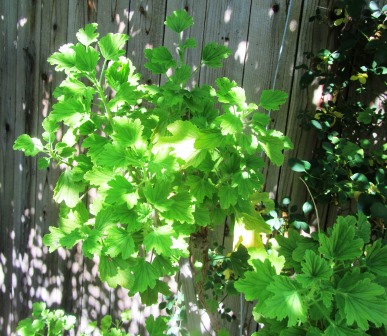
This lemon-scented Pelargonium crispum thrives in part shade and produces inch-wide, white-and-pink blooms
Brushing up against the leaves of a scented geranium releases fragrance to the area where they grow. It’s the main reason why these varieties are grown because those that bloom do not flower as colorfully or profusely as zonal geraniums.
They do, however, require the same care as zonals. They do best in well-drained, loose soil and this applies whether they are grown in pots or in the ground. They need water, but can tolerate some dry conditions.
Some scented geraniums grow from four-to-six feet tall with rounded leaves and range from a half inch to six inches (similar to oak leaves). Rubbing the leaves gently releases their potent and pleasing aroma.
Growing scented geraniums is easy and a delight to the senses. Why not try some in your garden? The following is a list of scented geraniums, suggestive of their diversity:
- Pelargonium crispum; lemon fragrance
- Pelargonium denticulatum; pine fragrance
- Pelargonium x fragrans; nutmeg fragrance
- Pelargonium graveolens; rose fragrance
- Pelargonium x nervosum; lime fragrance
- Pelargonium odoratissimum; apple fragrance
- Pelargonium scabrum; apricot fragrance
- Pelargonium tomentosum; peppermint fragrance
 Facebook
Facebook Goodreads
Goodreads LinkedIn
LinkedIn Meera Lester
Meera Lester Twitter
Twitter



